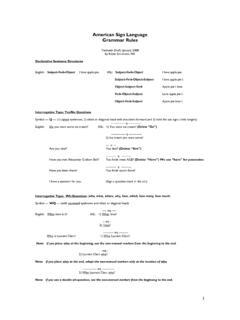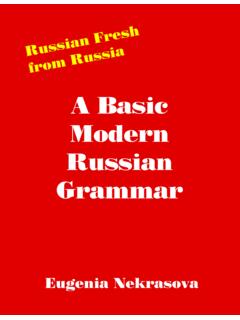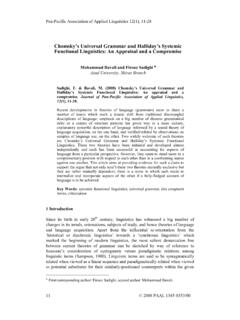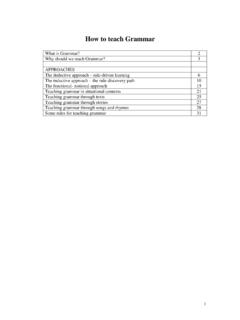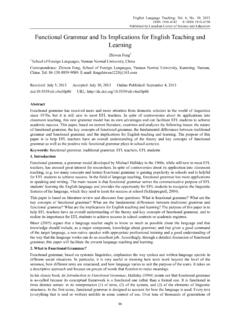Transcription of Modern French Grammar: A Practical Guide, Second Edition
1 Modern French grammar Second Edition Routledge Modern Grammars Series concept and development Sarah Butler Other books in series: Modern German grammar , Second EditionModern German grammar Workbook, Second Edition Modern Italian grammar Modern Italian grammar Workbook Modern Spanish grammar , Second EditionModern Spanish grammar Workbook, Second Edition Modern French grammar A Practical guide Second Edition Margaret Lang and Isabelle Perez LONDON AND NEW YORK. First published 1996. by Routledge Reprinted 1997, 2000, 2002 (twice), 2003. Second Edition published 2004. by Routledge 11 New Fetter Lane, London EC4P 4EE. Simultaneously published in the USA and Canada by Routledge 29 West 35th Street, New York, NY 10001. Routledge is an imprint of the Taylor & Francis Group This Edition published in the Taylor & Francis e-Library, 2005. To purchase your own copy of this or any of Taylor & Francis or Routledge's collection of thousands of eBooks please go to.
2 1996, 2004 Margaret Lang and Isabelle Perez All rights reserved. No part of this book may be reprinted or reproduced or utilised in any form or by any electronic, mechanical, or other means, now known or hereafter invented, including photocopying and recording, or in any information storage or retrieval system, without permission in writing from the publishers. British Library Cataloguing in Publication Data A catalogue record for this book is available from the British Library Library of Congress Cataloging in Publication Data Lang, Margaret, 1940 . Modern French grammar : a practicle guide/Margaret Lang and Isabelle Perez. 2nd ed. p. cm. (Routledge Modern grammars). Includes index. 1. French language grammar . 2. French language Textbook for foreign speakers English. I. Perez, Isabelle, 1962 . II. Title. III. Series. 2004. 421 dc22 2003026062.
3 ISBN 0-203-39725-8 Master e-book ISBN. ISBN 0-203-67129-5 (Adobe eReader Format). ISBN 0-415-33482-9 (hbk). 0-415-33162-5 (pbk). Contents Acknowledgements xi Introduction xii How to use this book xvii Glossary xix SECTION A Structures I The noun group 2. 1 Articles 2. 2 The definite article 2. 3 The indefinite article 9. 4 The partitive article 11. 5 Demonstrative adjectives 15. 6 Demonstrative pronouns 17. 7 Possessive adjectives 20. 8 Possessive pronouns 22. 9 Nouns 23. 10 Adjectives 31. 11 Indefinite adjectives, pronouns and adverbs 40. 12 Personal pronouns 51. 13 Re exive pronouns 56. 14 Emphatic pronouns; position and order of pronouns 56. 15 Relative pronouns 62. 16 Interrogative pronouns, adjectives and adverbs 67. 17 Cardinal and ordinal numbers 72. vi 18 Fractions 77. 19 Approximate quantities 78. 20 Dimensions 78. 21 Adverbs of quantity 80.
4 II The verb group 82. 22 Agreement of verb and subject 82. 23 Formation of tenses 86. 24 The indicative tenses; the present tense 86. 25 The future tense 93. 26 The imperfect tense 97. 27 The past historic 100. 28 The compound tenses 103. 29 How the perfect is used 104. 30 How the future perfect is used 107. 31 How the pluperfect is used 108. 32 How the past anterior is used 109. 33 The conditional and the conditional perfect 110. 34 The subjunctive 114. 35 The present subjunctive 114. 36 The imperfect subjunctive 116. 37 The perfect subjunctive 117. 38 The pluperfect subjunctive 117. 39 Sequence of tenses; uses of the subjunctive 117. 40 Re exive verbs 127. 41 The passive 129. 42 The past participle 132. 43 The present participle 137. 44 The imperative 139. 45 The infinitive 142. vii 46 Impersonal verbs 145. 47 Adverbs 147. 48 Prepositions 156.
5 SECTION B Functions III Exposition 159. 49 Referring to people, things and places 159. Physical characteristics 159. Personality 161. Relationships 162. Age 165. Ownership 167. Dimensions 172. Quantity and number 174. Quality 179. Comparison 180. Directions 184. Location 187. Manner 191. 50 Narrating 194. Present time 195. Past time 197. Future time 200. Dates and time 201. Sequence 205. 51 Reporting 208. 52 Asking questions 215. 53 Negating 219. IV Attitude 222. 54 Greeting and leave-taking 222. viii Greeting 222. Leave-taking 223. 55 Expressing congratulations and appreciation 225. Congratulations 225. Appreciation 226. 56 Expressing apologies and sympathy 228. Apologies 228. Sympathy 230. 57 Expressing surprise and disgust 232. Surprise 232. Disgust 234. 58 Expressing contrasting attitudes, emotions, feelings 235. Likes and dislikes 235. Preference 237.
6 59 Love and hate 238. 60 Enthusiasm and indifference 240. 61 Hopes, fears and regrets 241. 62 Approval and disapproval 243. V Argumentation 245. 63 Agreeing and disagreeing 245. Agreeing 245. Disagreeing 247. Agreeing to differ 250. 64 Asserting and confirming 251. Asserting 251. Confirming 252. 65 Admitting and conceding 253. Admitting 253. Conceding 254. ix 66 Correcting and protesting 255. 67 Contradicting and criticizing 258. 68 Suggesting and persuading 260. Suggesting 260. Persuading someone to think the way you do 262. Persuading someone to do/not to do something 264. Other ways of persuading and dissuading 264. 69 Expressing volition 267. Verbs expressing volition 268. Wishing and intending 269. Asking what someone intends 270. Asking someone for something 272. Expressing (un)willingness to act upon request 273. Deliberate or non-deliberate actions 275.
7 Saying what you do not want 276. 70 Expressing permission and obligation 278. Permission 278. Prohibition 279. Obligation 281. Exemption 285. 71 Expressing doubt and certainty 287. Doubt and certainty 287. Possibility and probability 292. Condition and hypothesis 298. 72 Expressing logical relations 302. Cause explicit 302. Cause implicit 306. Consequence explicit 307. Consequence implicit 311. x Aim 312. 73 Expressing opposition 315. 74 Structuring 321. Beginning 321. Continuing 326. Ending 328. VI The sounds of French 333. 75 Vowels 333. 76 Nasal vowels 333. 77 Semi-vowels/semi-consonants 333. 78 Consonants 334. 79 Accents, cedilla, diaeresis 334. 80 Liaison 335. 81 Elision 337. Verb tables 339. Index of grammar structures and functions 354. Acknowledgements The authors would like to thank the following for their permission to reproduce extracts from copyright material: Grasset, Paris, Roger Vailland, Un Jeune Homme Seul, 1951 (p.)
8 77) Le Monde and (pp. 83, 88); Plon, Paris, for , Grandeur Nature, 1936 (p. 86); The Guardian (p. 104); for G. Moustaki, Le M t que' (p. 134); Editions La D couverte, collection Rep res, Paris, for , La Population fran aise, 1989 (p. 139); Documentation europ enne for , Les Grandes Phases historiques' in Dix Le ons sur l'Europe, 1992 (p. 164); Journal Officiel des Communarit s Europ ennes for D bats du Parlement europ en (p. 205);. Capital, August 1994 (p. 245). Introduction This book is designed to provide the essential elements of French grammar , for students in the final year of school and in the first and later years of higher education. Advanced learners will find much that is useful for extending their knowledge of French , and for revision. The book is organized in two major sections: a reference section containing the structures of grammar and a section containing functional grammar .
9 Each section includes cross-references to the other. The reference grammar , which is as comprehensive as possible, has been structured around the noun phrase dealing with all the elements related to the noun: articles, pronouns, adjectives and numbers and the verb phrase dealing with all the elements related to the verb: tenses, mood, participles and adverbs. The functional grammar is composed of three parts, each demonstrating how to do things with language in order to communicate. The three principal functions identified are exposition, attitude and argumentation. Each of these is divided into smaller function areas related to the principal function. The functions Exposition Communication involves both giving and obtaining information: we make statements and we ask questions about someone or something. This involves (a) referring to people, things and places (b) narrating events in some sort of sequence (c) reporting what we or other people say or think.
10 In other words, we are giving or obtaining information about who, what, when, how, where and why. Exposition includes three groups of functions identified, very broadly, as referring, narrating and reporting. Referring to people, things and places involves giving and obtaining information about physical characteristics, personality, relationships, age, xiii ownership dimensions, quantity and number, quality or distinguishing characteristics, comparison, direction, location and manner. Narrating involves talking about events or actions in terms of present, past and future time, dates and time, and sequence. Reporting describes what we or other people say and write. Reporting is usually clearly indicated by the presence of an introductory verb. There are many verbs which can introduce reported speech of which the commonest is say'. Some of the others are think, remind, ask; hope, believe, want, suggest, answer, admit, forget'.


